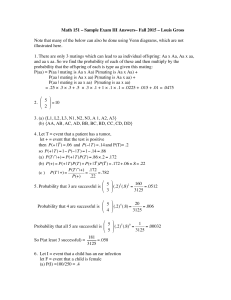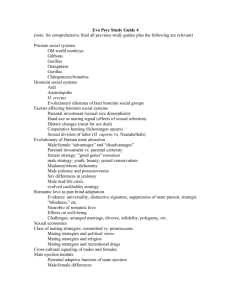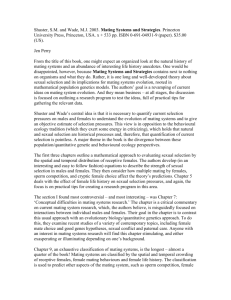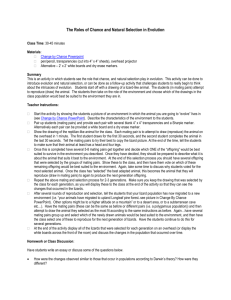SUPPORTING INFORMATION Differences across mating
advertisement
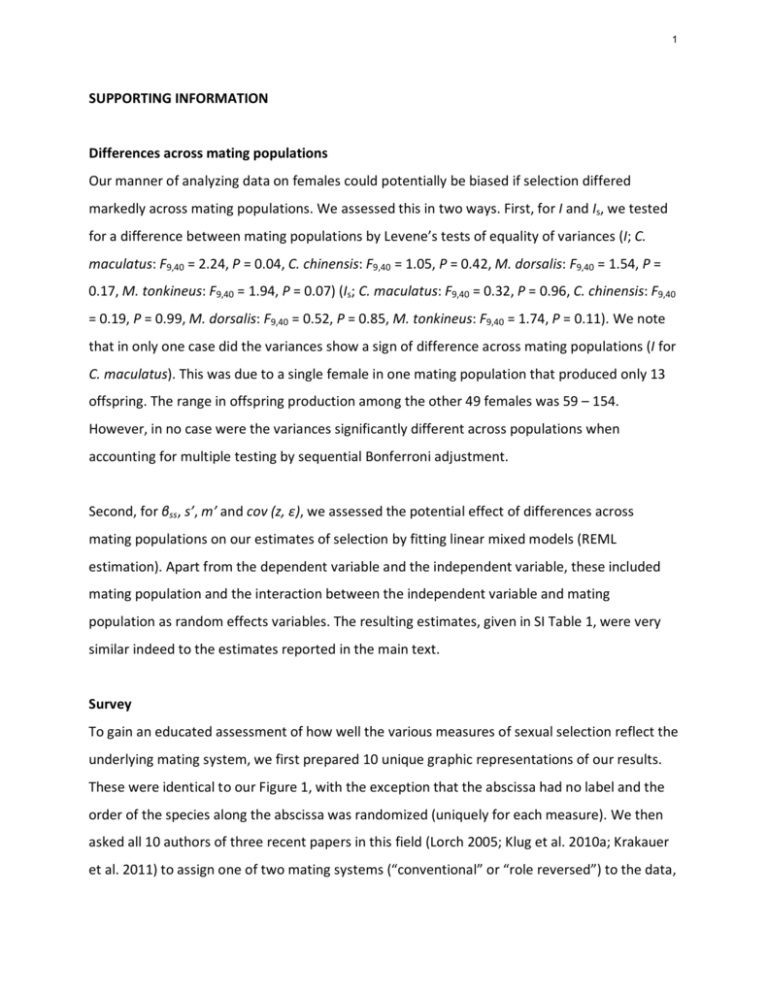
1 SUPPORTING INFORMATION Differences across mating populations Our manner of analyzing data on females could potentially be biased if selection differed markedly across mating populations. We assessed this in two ways. First, for I and Is, we tested for a difference between mating populations by Levene’s tests of equality of variances (I; C. maculatus: F9,40 = 2.24, P = 0.04, C. chinensis: F9,40 = 1.05, P = 0.42, M. dorsalis: F9,40 = 1.54, P = 0.17, M. tonkineus: F9,40 = 1.94, P = 0.07) (Is; C. maculatus: F9,40 = 0.32, P = 0.96, C. chinensis: F9,40 = 0.19, P = 0.99, M. dorsalis: F9,40 = 0.52, P = 0.85, M. tonkineus: F9,40 = 1.74, P = 0.11). We note that in only one case did the variances show a sign of difference across mating populations (I for C. maculatus). This was due to a single female in one mating population that produced only 13 offspring. The range in offspring production among the other 49 females was 59 – 154. However, in no case were the variances significantly different across populations when accounting for multiple testing by sequential Bonferroni adjustment. Second, for βss, s’, m’ and cov (z, ε), we assessed the potential effect of differences across mating populations on our estimates of selection by fitting linear mixed models (REML estimation). Apart from the dependent variable and the independent variable, these included mating population and the interaction between the independent variable and mating population as random effects variables. The resulting estimates, given in SI Table 1, were very similar indeed to the estimates reported in the main text. Survey To gain an educated assessment of how well the various measures of sexual selection reflect the underlying mating system, we first prepared 10 unique graphic representations of our results. These were identical to our Figure 1, with the exception that the abscissa had no label and the order of the species along the abscissa was randomized (uniquely for each measure). We then asked all 10 authors of three recent papers in this field (Lorch 2005; Klug et al. 2010a; Krakauer et al. 2011) to assign one of two mating systems (“conventional” or “role reversed”) to the data, 2 given only basic information about the system and the condition that two species should belong to each of the two mating systems for each graph (see an example below). The survey showed that educated raters were able to correctly assign mating system to the data using variance based measures of sexual selection but that they failed to do so using trait based measures (see SI Figure 1). 3 SI Table 1. Alternative ways of estimating sexual selection in females of the four species studied. Given are estimates based on (i) data standardized/relativized on a per mating population level (top part), (ii) those based on the same data instead standardized/relativized across all 50 females per species (middle part) and (iii) those estimated in linear mixed models (bottom part). In no case did the two alternative estimates under (i) and (ii) differ significantly (t-tests; range of P-values: 0.36-0.98). Species C. maculatus C. chinensis M. dorsalis M. tonkineus C. maculatus C. chinensis M. dorsalis M. tonkineus C. maculatus C. chinensis M. dorsalis M. tonkineus βss SE of βss Is SE of Is I SE of I m' SE of m' s' SE of s' Cov(z,ε) 0.171 0.096 0.617 0.872 0.105 0.070 0.116 0.109 0.076 0.260 0.093 0.318 0.018 0.092 0.024 0.100 0.042 0.063 0.095 0.425 0.025 0.034 0.031 0.111 0.004 0.275 0.030 0.099 0.044 0.073 0.050 0.089 0.078 0.067 0.092 0.099 0.031 0.037 0.050 0.103 0.064 0.033 0.059 0.010 βss SE of βss Is SE of Is I SE of I m' SE of m' s' SE of s' Cov(z,ε) 0.113 0.132 0.513 0.772 0.099 0.064 0.119 0.119 0.098 0.354 0.110 0.286 0.017 0.104 0.020 0.050 0.047 0.076 0.104 0.365 0.016 0.023 0.023 0.049 -0.005 0.201 -0.006 0.044 0.045 0.083 0.050 0.077 0.074 0.118 0.073 0.048 0.030 0.034 0.047 0.087 0.075 0.092 0.076 0.014 βss SE of βss m' SE of m' s' SE of s' Cov(z,ε) 0.171 0.101 0.618 0.872 0.105 0.081 0.146 0.109 0.004 0.274 0.027 0.099 0.045 0.089 0.076 0.093 0.078 0.067 0.092 0.099 0.052 0.037 0.075 0.118 0.078 0.041 0.075 0.013 4 0.999 0.823 0.258 <0.001 <0.001 <0.001 m' cov(z,ε) s' I βss Is 1.0 Rater success rate 0.9 0.8 0.7 0.6 0.5 0.4 Measures SI Figure 1. Rater success in identifying mating system (conventional or role reversed) for various measures of sexual selection, when ratings were blind (i.e., raters were uninformed of which mating system was associated with a particular observation). Error bars represent 95% Bayesian CI and P – values represent Fisher's exact tests for a difference between the observed success rate and the random expectation (i.e., 0.5). The success rate varied across measures of sexual selection (contingency table test, χ2 = 39.1, df = 5, P < 0.001). 5 Predicting mating system from indices of sexual selection As a part of a comparative empirical (!) study of sexual selection and mating system characteristics in a group of insects, we have made detailed measurements that allow estimation of what we might call “indices of sexual selection” in both males and females of four closely related species. These were done in small replicated populations, allowing intrasexual pre- and post-mating reproductive competition as well as pre- and post-mating sexual selection, and are based on (1) actual observations of all matings taking place, (2) determination of paternity/maternity of all offspring produced and (3) measurement of a common integrative key phenotypic trait in both sexes (body size – used to calculate selection gradients in all species and sexes). The mating systems of the four species differ dramatically. Two of the species show “conventional” sex roles (C), where males initiate matings: they search for and court/harass females. Two of the species show “reversed” sex roles (R), where most matings are initiated by females who search for and actively court males. We have used our data to calculate six different indices of sexual selection in both males and females. The methods and symbols used follow Jones 2009 (Evolution 63:1673-1684). If you are unfamiliar with any of the six metrics, see Jones (2009)! On the following two pages you will find six different graphs summarizing our results. Each graph shows four groups of bars. These are the four species. For each species, data for females (black bars) and males (white bars) are always kept together. However, the order of the four species along the abscissa is randomized and unique for each of the 10 people we ask to do us this favour. Thus, the species order varies across the six graphs that you see (and also across raters). This is what we ask you to do: simply look at the six graphs and, for each graph, provide an educated guess as to which two of the four species are “conventional” and which two are “reversed” in terms of their sex roles. The easiest way to provide an answer is to copy the text below into an email that you return to us: -----------------------Bg: Is: I: m´: s´: cov(z,ε): ----------------------For each metric, simply write two “C”’s and two ”R”’s and the order you think is correct (from left to right), as for example: -----------------------Bg: RRCC Is: CRRC Etc. etc. Needless to say, we guarantee that your replies will be treated with utmost discretion such that replies will be completely anonymous: we will enter data such that a particular person will not be associated with a given reply. Any information linking a person with a reply will be permanently erased. We are only interested in the sum of assignments. We thank you in advance for your efforts! Göran Arnqvist & Karoline Fritzsche Opportunity for selection (I) Opportunity for sexual selection (Is) Bateman gradient 6 1,6 1,4 1,2 1,0 0,8 0,6 0,4 0,2 0,0 0,6 0,5 0,4 0,3 0,2 0,1 0,0 0,8 0,6 0,4 0,2 0,0 Residual selection (cov(z,ε)) Selection differential (s') Mating differential (m') 7 0,5 0,4 0,3 0,2 0,1 0,0 0,5 0,4 0,3 0,2 0,1 0,0 0,35 0,30 0,25 0,20 0,15 0,10 0,05 0,00


